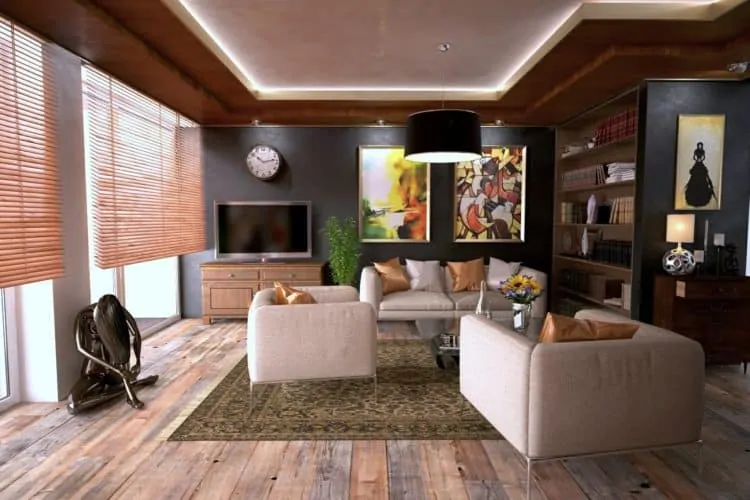
- By Remodel Works
- In Blog
What Are Engineered Wood Floors?
If you’re exploring floor options for your home, engineered wood floors should definitely be on your radar. Developed as an innovation of traditional wood floors (but with many of the same positive properties), engineered wood floors are gaining sweeping popularity in homes across the country. Here’s exactly what you need to know about engineered wood floors, including how they stack up to a few other popular flooring options, and how to keep them clean.
What is Engineered Wood Floors?
Engineered hardwood is a variation of true hardwood, but unlike conventional hardwood, which comes straight out of a tree and into your home, engineered hardwood is a more complex product that consists of several layers.
Unlike true hardwood, only the top and bottom layers of engineered hardwood consist of real wood or a manufactured a hardwood veneer that’s less than ⅛ of an inch thick. In some cases, the inner layers are made of plywood, high density fiberboard, or hardwood. The core layers make the hardwood more stable than regular hardwood, and the outer surface adds a uniqueness.
Due to this unique construction aspect, engineered wood floors tend to be more stable than other flooring options, as well as more resistant to moisture.
Origins of Engineered Wood Floors
Originally, engineered wood floors were developed for use on the first floor of a home built on a concrete slab or in a basement. However, according to popular home design resource, Houzz, engineered wood flooring technology has exploded over the last 20 years, and its products can be used just about anywhere.
Engineered Wood Flooring vs Hardwood
It used to be that solid hardwood flooring was the gold standard for flooring in homes, but over the last several years, engineered wood flooring has certainly risen as a competitor.
Today, engineered wood comprises a majority share of the wood floor market, and the two types of flooring are often mentioned in the same breath. While solid wood is still preferred for by purists who have long-time prospects in mind, engineered wood is a more practical choice that provides many of the same luxuries.
Here is a detailed breakdown of the primary differences between for engineered wood flooring vs laminate.
Material
As previously mentioned, engineered wood flooring is a layered product comprised of a thin slice of hardwood or veneer on top of a base of high-quality plywood. Solid hardwood, as you’d expect, is made up of hardwood, and is a completely homogeneous product from top to bottom.
Thickness
Solid hardwood is usually 3/4 inch thick, while engineered wood flooring is typically thinner, ranging from 3/8-1/2 inch thick. Because of the thicker nature of solid hardwood, it retains the traditional “solid” sound that has come to be associated with true hardwood floors.
Engineered floors, in contrast, can sound more hollow than solid under-foot, but that can be addressed by stapling down the planks instead of floating them. Premium engineered flooring is usually thick enough to look and sound just like “real hardwood”.
Wood Options
Natural hardwood offers significantly more choices of wood species than engineered wood. The most popular wood choices for natural wood are oak (red and white), maple, hickory, and pine.
Engineered wood flooring, in contrast, offers fewer choices than with solid hardwood. Oak, maple and hickory are also popular, plus softer species like birch, cherry and walnut, and exotic woods like African Mahogany, Acacia and Tigerwood.
Installation
Solid hardwood floors require traditional installation and are nailed or stapled down. Solid hardwood is never installed on a floating basis.
Engineered wood floors, on the other hand, are much easier than solid hardwood and provide a wide range of installation methods, such as stapling or nailing, click, or glue. The newest, thinnest engineered floors use an advanced system that locks them in place. These thin floor, or “floating floors,” can be overlayed on an older subfloor and are the easiest installation option.
Where to Install
There are a few inherent qualities of solid and engineered wood floors that specifically dictate where in the house they should (and should not) be installed. Solid wood flooring is best used in living areas, bedrooms, hallways, dining rooms. Solid wood is a great choice for the first and second floors, enhancing living spaces such as living rooms, dining rooms, kitchens and bedrooms.
It is recommended that solid wood not be used in kitchens or bathrooms, and if you are dead-set on doing so, waterproof mats are placed near sink and dishwasher. An important rule of thumb of solid wood floors is to never install them below grade.
For engineered hardwood, you should follow many of the same room recommendations as solid wood, but there is more slightly flexibility. Engineered wood is an excellent choice for areas where solid hardwood cannot be installed, like in basements, over concrete floors or over radiant heating systems. Engineered hardwood can be installed below-grade, in basements, with proper subfloor and as long as there are no significant moisture issues.
Durability
Solid hardwood is known for its endurance. Because it is solid through and through, it can be sanded and refinished multiple times during a lifetime. Moisture is definitely the enemy of solid hardwood, which is why this material is never recommended for bathrooms, basements, or other areas where moisture is prevalent or even expected. Solid hardwood can resist some moisture, especially site-finished wood flooring (as opposed to pre-finished), which has a sealed top layer to help expel some moisture. Do not make the easily avoidable mistake of installing a floor type that’s not compatible with the room you’re remodeling.
If your durability concerns are around moisture, humidity or temperature, engineered wood floors are the way to go, since their layered construction provides stability against environmental changes. Engineered wood is a better option for rooms exposed to lots of moisture — the plywood base of engineered hardwood is dimensionally stable, meaning that it warps and flexes less easily upon contact with moisture than solid wood. Fibers in plywood run in cross-wise layers, which creates a far more stable structure than solid wood’s parallel fibers.
Price
Solid is the gold standard in flooring, and it’s usually the most expensive flooring option out there. Solid hardwood can vary, depending on finish and warranty, but in general, you can expect to pay more for this material.
As a whole, engineered wood floors tend to be less expensive than solid hardwood. But in comparison to other flooring materials, engineered floors are still considerably more expensive than laminate, tile, and carpet. Engineered wood flooring prices range from $3 to $18 per square foot.
Investment Value
Solid hardwood is traditionally the best floor choice for investment value. It’s a classic choice for floor purists, and a traditional, beautiful flooring option that will extend the life and value of any home.
Engineered wood floors are a sneakier option for investment value. Because engineered wood floors are real wood, they can be advertised as such in real estate marketing materials, making them more attractive to buyers.
Engineered Wood Flooring vs Laminate
Another common comparison that’s often made of floor material contenders is engineered wood flooring vs laminate.
What’s the Difference?
Unlike engineered wood floors, which typically contain some aspect of real hardwood, laminate is a purely synthetic flooring product. The top layer has an imprinted textured image made to look like real wood.
The core layer of laminate flooring is manufactured from melamine resin and fiber board material. The flooring material is usually 1/3 inch thick, which makes it thinner than both solid hardwood and engineered hardwood. Because of the thinner nature, laminate can be laid over existing floors with relative ease.
In essence, while engineered hardwood flooring is typically manufactured from real wood and preserves the unique textured grain and appearance of natural wood, laminate flooring is only an imitation. Some high quality laminate floors will look truer to real wood than other, cheaper options.
Aesthetic
Regarding appearance, the difference between hardwood and laminate floors is pretty easy to spot.
One of the defining characteristics of engineered hardwood is its resemblance to true wood floors, specifically, a telltale texture variation of the wood grain, which is why no two planks of engineered wood flooring (or, of course, hardwood flooring) appear exactly alike.
In laminate flooring, though, pre-designed patterns that imitate the look of wood texture, are imprinted onto the floor surface. For this reason, identical patterns are repeated on average every 5 boards. This repetition of texture is an easy way to spot manufactured flooring like laminate, against the more realistic looking solid or engineered wood.
Moisture-Tolerance
An advantage of laminate floors against engineered wood floors is that they have high resistance to moisture. For this reason, they are often used for kitchens, bathrooms, and basements. There are waterproof variations of laminate flooring that are made completely of plastic.
Maintenance
Regular sweeping, dry mopping, or wiping with a damp cloth is all that’s necessary for cleaning and maintaining laminate flooring. Solid and engineered hardwood floors require a little more care – they should be cleaned using special hardwood flooring cleaners (preferably manufacturer recommended ones) that preserve and restore the finish.
Ease of Repair
Laminate flooring varies in its ease of repair. In floating laminate flooring, damaged planks can easily be removed and replaced with new planks. There is, of course, the possibility that the new plank will not match the rest of the floor, in terms of wear and tear, but generally, this installation option is preferable for the ease of floor replacement.
If laminate flooring was installed using the glue-down method, then repair and replacement is much more difficult and intensive. Laminate flooring cannot be sanded or refinished at all.
In general, engineered hardwood flooring is significantly easier to repair than laminate. If the surface damage is significant, then the entire floor can be sanded and refinished. If damage is localized, then it can be repaired by removing and replacing individual planks. Spot repairs can also be managed by manually sanding, staining and refinishing the problem area (depending on the type of finish). Spot repairs are especially easy with wire brushed and oiled hardwood floors and can be done DIY-style within a couple of hours.
Cost
Undoubtedly, the biggest advantage of laminate flooring is the price. The material itself is cheaper, and with the ease of installation, you can avoid installation costs altogether. Also, since laminate is pressed wood, it’s even more durable and resistant to scratches and dents, which also reduces the cost of maintenance and repair down the line.
How to Clean Engineered Wood Flooring
Before making the decision to add engineered wood flooring to any level of your house, it’s important to be clear about the biggest ongoing factor: maintenance.
Since engineered hardwood is made from wood, it requires almost the same cleaning methods as any other type of wood flooring. The great news about engineered wood flooring specifically is that the material typically smooth enough to not trap dust and allergens. It’s also easy to clean with a damp mop and special wood cleaner.
Step by Step Guide to Cleaning Engineered Wood Floors
Check out the below step-by-step instructions for taking care of your engineered floors:
- Keep your engineered flooring swept, clean, and dry on a daily basis using a vacuum cleaner with a soft flooring attachment, or a broom.
- Use a dry microfiber dust mop to pick up dirt and debris from the floor.
- Wipe up spills as soon as they occur. Excessive water or liquid can cause irreversible damage to engineered hardwood flooring.
- Place floor mats and rugs at all entrances to limit the amount of surface debris on your floors.
- This will help keep the upper wear layer and finish of your floor safe and intact for a longer period of time.
- Do not use wax-based cleaners, harsh detergents, or steel wool to clean engineered hardwood flooring.
- Consider periodic waxing and refinishing to keep your floors in top shape.
- Use furniture pads to prevent unsightly scratches.
Ultimately, your wood flooring choice is going to be determined by where you are planning to install the product and what you’re looking for regarding design aesthetic. Engineered wood flooring is a great choice for lower levels of the home, or areas where moisture is high.
The bottom line is this: engineered wood floors offer a beautiful finish and will increase the value of your home.










